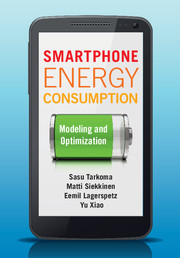Book contents
- Frontmatter
- Contents
- Preface
- List of abbreviations
- Part I Understanding energy consumption
- 1 Introduction
- 2 Energy and power primer
- 3 Smartphone batteries
- 4 Energy measurement
- 5 On human behavior and energy efficiency
- Part II Energy management and conservation
- Part III Advanced energy optimization
- Appendix A An energy profile application
- Index
- References
4 - Energy measurement
from Part I - Understanding energy consumption
Published online by Cambridge University Press: 05 August 2014
- Frontmatter
- Contents
- Preface
- List of abbreviations
- Part I Understanding energy consumption
- 1 Introduction
- 2 Energy and power primer
- 3 Smartphone batteries
- 4 Energy measurement
- 5 On human behavior and energy efficiency
- Part II Energy management and conservation
- Part III Advanced energy optimization
- Appendix A An energy profile application
- Index
- References
Summary
To improve the energy efficiency of a smartphone, a reliable way to measure the energy consumption of the phone is required. A reliable energy measurement method gives consistent results under the same usage scenario, and responds quickly to variations in energy use. Any energy-efficiency improvements, and energy performance with different workloads, can then be measured with the energy-measurement method.
This chapter discusses energy measurement. We discuss the nature of energy and how it must be measured, and the case of the smartphone and its subsystems as the object of study. We explain direct hardware measurement of power, profile-based software power estimation, building such profiles from hardware measurements, and conclude with a hands-on example.
Hardware- and software-based energy measurement
Draining energy from a battery is a continuous chemical process. The only way to be sure how much energy is being consumed is to measure it constantly as it is being drained. However, doing this affects the use of energy in different ways depending on the measurement method used.
There are two main types of energy measurement: hardware-based and software-based. Hardware-based measurement uses physical tools like power meters that are wired to the smartphone hardware and/or the battery interfaces. Software-based measurement runs on the smartphone energy-profiling software that records the readings of platform-specific built-in indicators of energy use. Note that the software used for measurement also drains the smartphone battery.
- Type
- Chapter
- Information
- Smartphone Energy ConsumptionModeling and Optimization, pp. 59 - 72Publisher: Cambridge University PressPrint publication year: 2014



